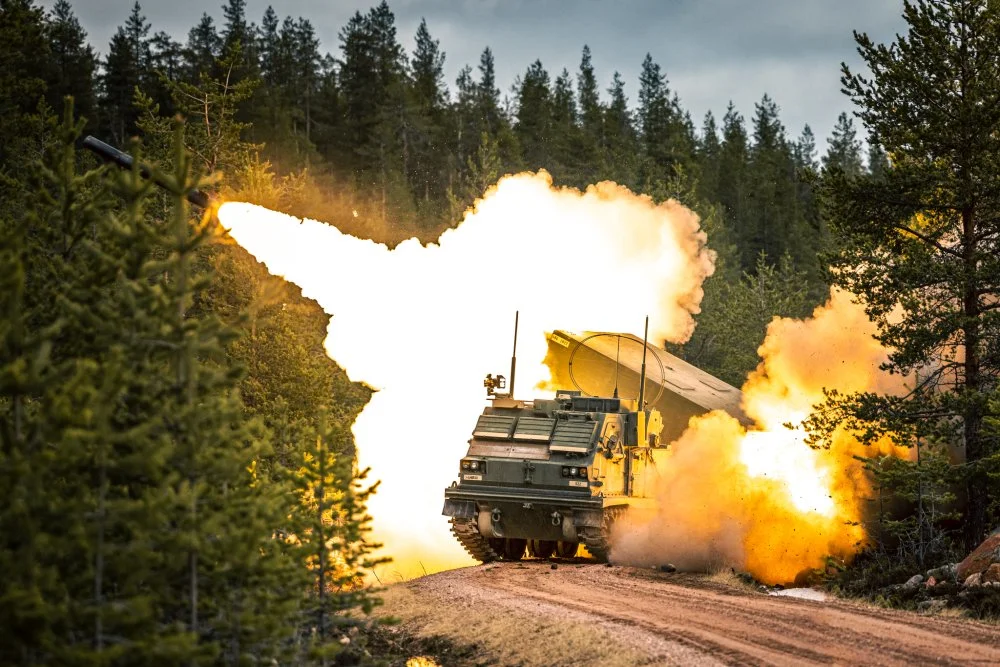Analyzing The Potential Of A Joint Swedish-Finnish Military Force

Table of Contents
Enhanced Military Capabilities and Resource Sharing
Pooling resources for a joint Swedish-Finnish military force offers significant advantages in terms of firepower and operational efficiency. The combined strengths of both nations' armed forces create a formidable defense structure.
Pooling Resources for Superior Firepower:
The Swedish and Finnish militaries possess complementary capabilities. Sweden boasts a strong air force and naval assets, while Finland excels in land warfare and possesses extensive experience in asymmetric warfare. Combining these strengths creates a powerful synergistic effect.
- Improved air defense systems: A unified air defense network would offer significantly improved coverage and protection against aerial threats.
- Enhanced naval surveillance capabilities: Combined naval forces would enhance surveillance and control of the Baltic Sea, crucial for protecting vital sea lanes and deterring potential aggression.
- Combined artillery power: Pooling artillery resources would provide greater firepower and range, enhancing defensive capabilities significantly.
- Cost-effectiveness through shared procurement: Joint procurement of military equipment would lead to economies of scale, reducing the overall cost burden for both nations.
Increased Operational Efficiency and Interoperability:
Standardization across the joint force is key to maximizing effectiveness. This includes equipment, training, and command structures.
- Streamlined logistics: Unified logistics systems would improve the efficiency of supplying and maintaining the force.
- Reduced duplication of effort: Eliminating redundant capabilities and resources will free up funds and manpower for other priorities.
- Improved response times to threats: A more integrated command structure will facilitate faster and more coordinated responses to security threats.
- Enhanced interoperability with NATO forces: Standardization will improve compatibility and ease of integration with NATO allies, strengthening the alliance's eastern flank.
Strengthening Regional Security and Deterrence
A joint Swedish-Finnish military force would significantly bolster regional security and deterrence against external threats.
Deterrence Against External Threats:
The combined military strength of Sweden and Finland will serve as a powerful deterrent to potential aggressors.
- Increased military presence in the Baltic Sea: A larger, more visible military presence will deter potential acts of aggression.
- Enhanced intelligence sharing: Combined intelligence capabilities will provide a more comprehensive picture of potential threats.
- Stronger collective defense posture: The combined force will project a stronger and more credible defense posture.
- Improved crisis response capabilities: The unified force will be better equipped to respond swiftly and effectively to crises.
Bolstering NATO's Eastern Flank:
While both countries maintain their neutrality, a joint force would indirectly benefit NATO's eastern flank security.
- Enhanced security for neighboring NATO members: The increased military presence would contribute to the overall security of neighboring NATO countries.
- Increased stability in the Baltic region: A stronger military force enhances regional stability, discouraging potential aggression.
- Improved burden sharing within the alliance: Although not directly part of NATO, the increased security provided indirectly reduces the burden on existing NATO members.
- Strengthened transatlantic ties: The combined force demonstrates a commitment to collective security, further solidifying transatlantic ties.
Challenges and Potential Obstacles
While the benefits are substantial, a joint Swedish-Finnish military force faces significant challenges.
National Sovereignty Concerns:
Balancing national interests and maintaining a degree of autonomy within the joint force is vital.
- Balancing national interests: Negotiating and balancing the differing national interests of both countries will require careful diplomacy.
- Maintaining independent defense capabilities: Both countries will need to ensure they maintain sufficient independent capabilities to address unique national security needs.
- Establishing clear command structures: Defining clear command structures and decision-making processes is crucial to ensure efficient operations.
- Political sensitivities: Addressing the political sensitivities surrounding military integration requires careful consideration of public opinion and political realities.
Integration Challenges:
Integrating distinct military doctrines, equipment, and training procedures is a complex undertaking.
- Standardization of weapons systems: Harmonizing the different weapon systems used by both militaries will be a lengthy and expensive process.
- Harmonization of military ranks and regulations: Aligning military ranks and regulations will require considerable effort and compromise.
- Cultural differences: Overcoming cultural differences and fostering a cohesive military culture will require dedicated effort.
- Potential language barriers: Language barriers may present challenges to communication and coordination within the joint force.
Economic and Political Implications
The joint force holds significant economic and political benefits.
Economic Benefits of Collaboration:
Resource pooling offers significant cost savings.
- Reduced military spending per capita: Shared resources will reduce the overall military burden on both nations.
- Increased efficiency in defense industries: Collaboration will promote efficiency and innovation within the defense industries.
- Stimulation of joint research and development: Combined research and development efforts will lead to more advanced military technologies.
- Potential for export opportunities: A unified defense industry could increase export opportunities for both nations.
Strengthened Political Ties and Regional Influence:
The joint force will undoubtedly enhance Sweden and Finland's political standing.
- Increased regional influence: The combined force will provide both countries with greater regional influence.
- Strengthened collaboration with other Nordic countries: The joint force could serve as a model for greater Nordic defense cooperation.
- Enhanced voice in international security affairs: The combined force will give both nations a stronger voice in international security forums.
- Improved international credibility: The joint force will enhance both countries' international credibility and standing.
Conclusion:
The potential formation of a joint Swedish-Finnish military force presents both significant opportunities and challenges. While concerns regarding national sovereignty and integration complexities exist, the potential benefits in terms of enhanced military capabilities, regional security, and economic efficiency are considerable. A carefully planned and executed integration process, prioritizing open communication and mutual respect, is crucial for realizing the full potential of this ambitious undertaking. Further analysis and debate on the implications of a joint Swedish-Finnish military force are vital for ensuring its success and maximizing its contribution to Nordic and European security. The future of Nordic defense cooperation may well depend on the effective implementation of this bold strategy. Continued discussion and strategic planning regarding the joint Swedish-Finnish military force are vital for securing a stable and secure future for the Nordic region.

Featured Posts
-
 Understanding The Bank Of Canadas Decision Insights From Fp Video
Apr 22, 2025
Understanding The Bank Of Canadas Decision Insights From Fp Video
Apr 22, 2025 -
 Why Nike Shoe Production Remains A Challenge For Robots
Apr 22, 2025
Why Nike Shoe Production Remains A Challenge For Robots
Apr 22, 2025 -
 U S China Relations Breakdown And The Looming Cold War
Apr 22, 2025
U S China Relations Breakdown And The Looming Cold War
Apr 22, 2025 -
 Is Betting On Wildfires Like The Los Angeles Fires A Sign Of The Times
Apr 22, 2025
Is Betting On Wildfires Like The Los Angeles Fires A Sign Of The Times
Apr 22, 2025 -
 Hollywood Strike Actors Join Writers Bringing Production To A Halt
Apr 22, 2025
Hollywood Strike Actors Join Writers Bringing Production To A Halt
Apr 22, 2025
